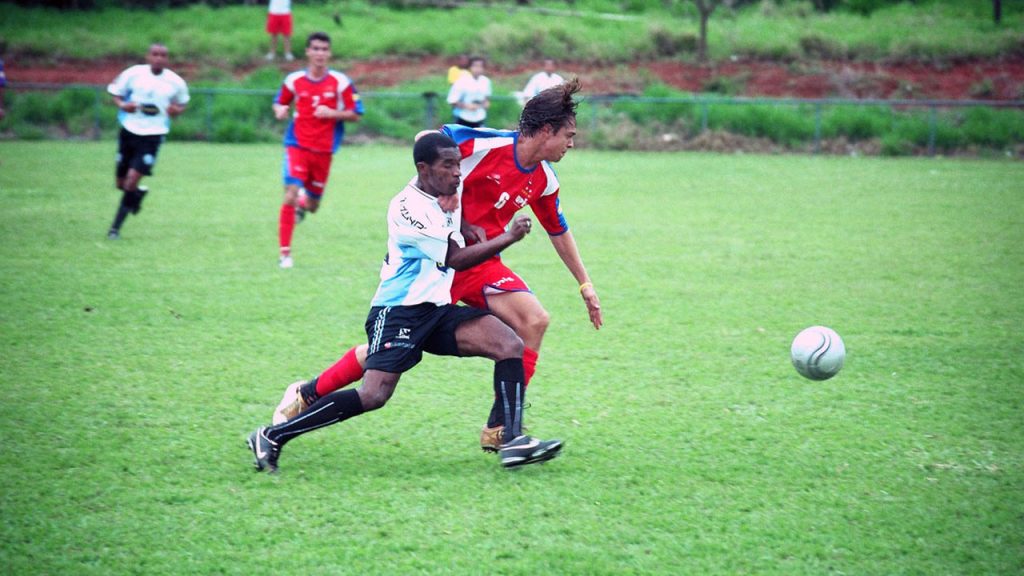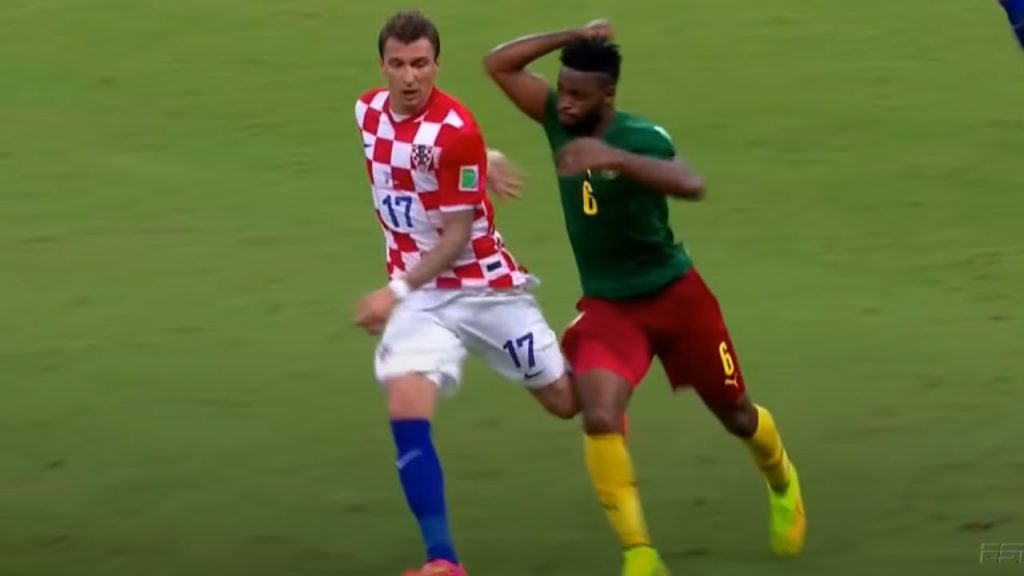Authority Soccer (authoritysoccer.com) is a participant in the Amazon Services LLC Associates Program, an affiliate advertising program designed to provide a means for sites to earn advertising fees by advertising and linking to Amazon.com. This site also participates in other affiliate programs and is compensated for referring traffic and business to them.
We are in the middle of a game, facing this quick winger that loves to kick the ball behind us and reach the ball first.
They beat us every time, so the next time they do it, we casually get in their way when they run for the ball. We force them to lose momentum, and one of our teammates will reach the ball first.
The ref stops the game, foul, obstruction. We pretend we don’t know what happened, what is an obstruction, we ask.
Impending the progress of an opponent without contact, that’s how FIFA named in the 2020/21 rules the obstruction offense.
If a player moves into the opponent’s path to block, obstruct, slow down, or force a direction change when the ball is not within playing distance, the foul is called.
FIFA contemplates the right every soccer player has to try and get the ball. Still, there is a difference between being in the way of an opponent and moving deliberately into an opponent’s path.
The obstruction rule also contemplates the possibility of shielding the ball, which is legal.
What is the obstruction rule in soccer?
There are some plays we see in other sports that are illegal in soccer. We are used to seeing screenings in the NBA. A massive forward or center would stand next to a defender chasing a dribbler.
That’s perfectly legal in basketball, a player blocking the other’s path deliberately.
In soccer, the rule says that impending an opposite player to reach the ball when the ball is not within a playing distance is a foul.
To be precise, the obstruction rule was replaced by the “impending progress rule” in 1997. Technically, there is no obstruction rule, although we keep calling it that.
The game’s authorities decide to modify the rule to make the referee’s lives more comfortable and make the game fair for both parties, attackers, and defenders.
The old obstruction rule offered a tremendous advantage for defenders; the punishment was minimal for blocking goal occasions.
As we can see, the rule seems simple, but it can be complicated for the referee to call it. The most significant difficulty about it is the “without contact” part.
That means blocking the path of an opposing player without touching them. So if a player opens their arms to block the way or push or shoves, there is contact; therefore, a foul must be called.
The punishment for an impending offense is an indirect free kick.
If you start paying attention, you will see that it is not very common in soccer for a referee to call an indirect free kick.
The old rule of obstruction contemplated contact. So if a player moved into a rival’s path, perhaps forcing the contact, an obstruction foul was called.
But as the old saying goes, “done the law, done the snare.” Defenders would prevent a forward’s advance by blocking the way and would be punished with an indirect free kick inside the box.
That sounds like an excellent deal to trade a certain goal for an indirect free kick.
The other problem might be determining whether the ball is at a playing distance or not or if the player is intentionally blocking the path.
Some players will try to fool the referee by moving into the rival’s path on the sly. The blocked player will complain, the referee must evaluate and decide.
Screening in soccer is also considered an obstruction; players are not supposed to do it. But again, some would try to do it sneakily and get away with it.
At the same time, players have the right to stand wherever they feel like or wherever they think will help their teams. Forwards can sometimes seize the obstruction foul by crashing into a standing defender, claiming they were obstructed.
Why is shielding the ball, not obstruction?

The second part of the impending rule says that “(…) when the ball is not whiting a playing distance.” That is why shielding the ball is not considered an offense.
A player shielding the ball has possession of it, which means it is whiting a playing distance.
A player can use his entire body to protect and cover the ball when it is their possession. This means the player can extend their arms or even use their legs to prevent the rival’s passage to the ball.
A player shielding the ball can push backward whit their hips or even keep their ground firmly.
In the 2020/2021 rules, shielding is allowed as long as the opponent looking for the ball is not held off. Meanwhile, the ball is within a playing distance, the player protecting the ball can be legitimately charged by the opponent.
Some players mastered the art of shielding the ball, like Ronaldinho, Paul Gascoine, Juan Román Riquelme, Sergio Busquets, and many others. There are a few techniques for protecting the ball, a few different tricks.
1. Keep the ball away
The defender is behind us, or we give them our back. Then, the player shielding the ball must lean back, creating distance between the defender and the ball.
One leg stands its ground, and the other one extended controls the ball far from the defender.
2. Use your arms
It is legal to put our forearm on the defender’s chest to hold our space. We are not supposed to push them or pull their shirt, but it is entirely legal to stand our ground, helping us with our forearm.
3. Lower your gravity center
It is important to bend your knees a little and lower your gravity center. This will give you more stability, making it harder for the defender to push you over.
4. Switch feet
If the defender tries to reach the ball around us, we can either start circling too or switch feet, control the ball with the other leg, and put the other forearm in the defender’s chest.
5. Spin-off
As we shield the ball with our forearm in a rival’s chest, we get a lot of information from them. Their position obviously, but also where are they heading at?
Are they coming from our left? We spin right. Are they pushing? We use their impulse to bounce and sprint, taking advantage of the momentum.
6. Be mindful of grabbing
In the middle of the struggle, there could be a little shirt or shorts grabbing. The defender might hold you a little, so could you. Don’t grab too much; avoid an offensive foul.
But, if the defender pulls your arm firmly, don’t fight it back; just spin and try to get away from them; if the grabbing persists, it is a foul. If they release you, you are free.
7. Shielding is not meant to last
Although shielding is an effective way to keep possession, shielding is a means, not an end. After protecting the ball a few seconds, look for a pass or get out of there dribbling.
Is obstruction in the box a penalty?

No, an impending offense inside the box should be punished with an indirect free kick. But as we mentioned before, it would be hard to imagine a forward having a defender in front of them, blocking the path toward the ball, and not forcing the contact.
The striker will keep running and end up colliding with the defender blocking his way. If there’s a contact inside the box, a penalty must be given.
But as we have seen, the impending rule can be tricky; a defender might pretend not to move in the forward’s path deliberately and still find a way of casually blocking the striker’s route toward the ball.
The ref’s job is to focus on whether there was contact or not, or it is the defender moving into the forward’s path or the forward forcing the contact.
It happens something similar to the so-called dangerous play. A dangerous play is a movement made by a player that is considered potentially harmful for a rival.
For example, a player raises their leg too high or tries a bicycle shot too near a rival’s head.
If there is no contact, if the player raises the leg, doesn’t touch their rival, it is called a dangerous play offense. An indirect free kick is given, even if the infraction is inside the penalty area.
Even if the defender hits the ball, and the referee considers it was a dangerous move, an indirect free kick will be given inside the box.
But, if a dangerous move from a defender hits a rival, whether it be on the chest, a leg, or the head, it is a foul.
There’s some confusion about the impending rule. Perhaps because it is a relatively new rule and because it is rarely called.
Some think that because players are aware of the rules, and defenders know that they will rarely get away with just an indirect free kick, they know they risk a penalty.
The UEFA and FIFA referee Padraigh Sutton believes that if players knew that there is a way of being punished only with an indirect free kick, we would see those infractions more often.

